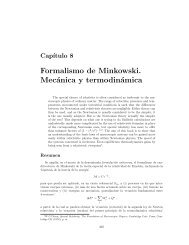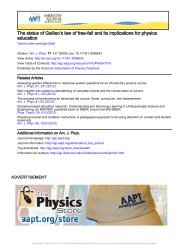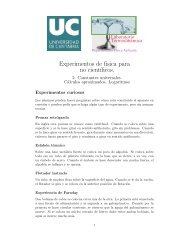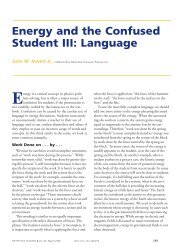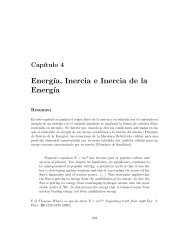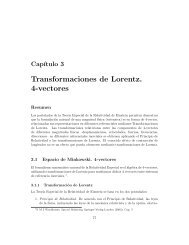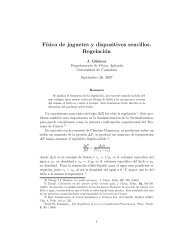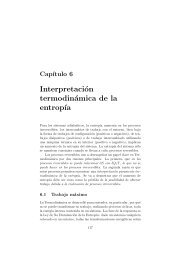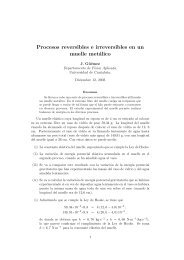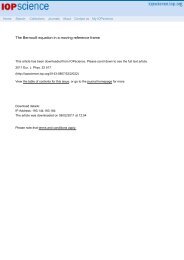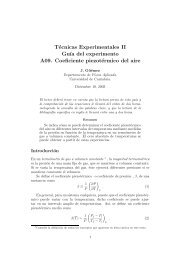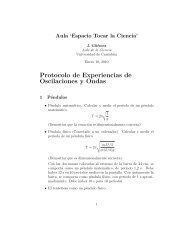Special Relativity in Week One: 1) The Principle of ... - Loreto-Unican
Special Relativity in Week One: 1) The Principle of ... - Loreto-Unican
Special Relativity in Week One: 1) The Principle of ... - Loreto-Unican
Create successful ePaper yourself
Turn your PDF publications into a flip-book with our unique Google optimized e-Paper software.
went up <strong>in</strong> the air over Boston, the Earth turned for threehours under the plane, and then the plane came back down <strong>in</strong>San Francisco. It was the Earth that moved, not the plane.Def<strong>in</strong>ition <strong>of</strong> the pr<strong>in</strong>ciple <strong>of</strong> relativity<strong>The</strong> stage is now set for a more precise def<strong>in</strong>ition <strong>of</strong> thepr<strong>in</strong>ciple <strong>of</strong> relativity. Imag<strong>in</strong>e that you are <strong>in</strong> a capsule andyou may have any equipment you want <strong>in</strong>side the capsule. <strong>The</strong>pr<strong>in</strong>ciple <strong>of</strong> relativity states that:<strong>The</strong>re is no experiment that you can performthat will allow you to determ<strong>in</strong>e that thecapsule is mov<strong>in</strong>g with uniform motion.We po<strong>in</strong>t out that our classroom is such a capsule. Due tothe rotation <strong>of</strong> the Earth, the motion <strong>of</strong> the Earth about theSun, the fact that the Sun is carried around by rotation <strong>of</strong>the Milky Way galaxy, and then there is the expansion <strong>of</strong> theuniverse, all these contribute to the motion <strong>of</strong> our classroom.But only the rotation <strong>of</strong> the Earth, which carries us around<strong>in</strong> a circle every 24 hours, has been directly observed. Whenyou are mov<strong>in</strong>g <strong>in</strong> a circle, you are not mov<strong>in</strong>g <strong>in</strong> a straightl<strong>in</strong>e. This slight deviation from uniform motion can bedetected with a Foucault pendulum.Speed <strong>of</strong> waves<strong>The</strong>re is one experiment that was expected to allow us todetect uniform motion. That experiment <strong>in</strong>volved the measurement<strong>of</strong> the speed <strong>of</strong> a light wave.To illustrate why such an experiment might be important,we start with an analogous experiment that is easier to observe.It is the measurement <strong>of</strong> the speed <strong>of</strong> a compressionalpulse on a stretched Sl<strong>in</strong>ky. Figure 2 is a photograph <strong>of</strong> astretched Sl<strong>in</strong>ky suspended from a steel pipe. <strong>The</strong>re is a support<strong>in</strong>gthread from the pipe down to every fourth coil <strong>of</strong> theSl<strong>in</strong>ky.If you pull back on one end <strong>of</strong> the Sl<strong>in</strong>ky and let go, you geta compressional pulse like the one shown <strong>in</strong> Fig. 3, that travelsdown the Sl<strong>in</strong>ky, reflects at the far end, and returns. Althoughwe had demonstrated these Sl<strong>in</strong>ky pulses for many years, onlyrecently did we do a careful analysis <strong>of</strong> the speed v pulse <strong>of</strong> acompressional pulse. <strong>The</strong> result was v pulse= KL / µ , where Kis the Hooke’s law spr<strong>in</strong>g constant, L the length <strong>of</strong> the Sl<strong>in</strong>ky,and m its mass per unit length. 3,4A phenomenon observed by David Keeports 5 is that thetime it takes for the pulse to travel down the spr<strong>in</strong>g and comeback does not depend on how much you stretch the spr<strong>in</strong>g. Tosee why, write the mass per unit length as m = m/L, where m isthe mass <strong>of</strong> the spr<strong>in</strong>g. <strong>The</strong>n our formula for v pulse becomes2vpulse = KL = KL = LK .m / L m m<strong>The</strong> time T it takes the pulse to go down and back, a distance2L, is T = 2L/v pulse . <strong>The</strong> factors <strong>of</strong> L cancel, with the resultthat T should not depend on L. Figure 4 shows our test <strong>of</strong> thisfeature <strong>of</strong> the pulse speed formula. We tripled the length <strong>of</strong>the Sl<strong>in</strong>ky from 83 cm to 260 cm, and the time the pulse tookto go down and back changed by only one video frame, 2.83 sto 2.87 s.<strong>The</strong> po<strong>in</strong>t <strong>of</strong> our Sl<strong>in</strong>ky experiment is that we have a formulafor the speed <strong>of</strong> the Sl<strong>in</strong>ky wave pulse, and that we canuse a video camera and simple algebra to precisely test thatformula.Relative motion<strong>The</strong> next experiments are where we study my motion relativeto the Sl<strong>in</strong>ky. As shown <strong>in</strong> Fig. 5(a), I hold a meterstickSunSunFig. 2. Sl<strong>in</strong>ky suspended by threads from a pipe.supersonic jetsupersonic jetBostonSanFranciscoSanFranciscoBostonFig. 3. Compressional pulse.rotat<strong>in</strong>gEarthrotat<strong>in</strong>gEarthFig. 1. A hypothetical trip from Boston to San Francisco.Fig. 4. We tripled the length <strong>of</strong> the Sl<strong>in</strong>ky and the pulse tookone more video frame to go down and back.<strong>The</strong> Physics Teacher ◆ Vol. 49, March 2011 149
pulse pass by me at twice the predicted speed, I had experimentalevidence that I was mov<strong>in</strong>g relative to the Sl<strong>in</strong>ky. If Isee the light pulse pass by me at twice its predicted speed, Ihave experimental evidence that I am mov<strong>in</strong>g relative to themedium through which light moves.But light moves through empty space. Observ<strong>in</strong>g the lightpulse pass<strong>in</strong>g by at a speed 2c allows me to detect my motionrelative to empty space. It allows me to violate the pr<strong>in</strong>ciple <strong>of</strong>relativity.If anybody observes a light pulse mov<strong>in</strong>g throughempty space at a speed different than the predicted speed 7c = 1/ µ ε , 0 0 he or she will be able to violate the pr<strong>in</strong>ciple <strong>of</strong>relativity. Thus, if the pr<strong>in</strong>ciple <strong>of</strong> relativity is correct, we havethe result <strong>of</strong> E<strong>in</strong>ste<strong>in</strong>’s second postulate, that the speed <strong>of</strong> lightmust be the same to all observers.This second postulate is counter<strong>in</strong>tuitive. It does not workfor familiar objects like automobiles. <strong>The</strong>re is no such th<strong>in</strong>gas a car that travels at 100 km/hr relative to everybody. Ifyou stand beside the road and a car passes you at 100 km/hr,someone driv<strong>in</strong>g <strong>in</strong> the opposite direction at the same speedsees the first car pass him or her at 200 km/hr. How can it bethat light pulses behave differently? <strong>The</strong> answer, we po<strong>in</strong>t out,is that light moves at an <strong>in</strong>credible speed that is well beyondour realm <strong>of</strong> experience. <strong>One</strong> <strong>of</strong> the most important lessons<strong>of</strong> physics is that when we look <strong>in</strong> a realm we have not seenbefore—the realm <strong>of</strong> high speeds, huge distances, or t<strong>in</strong>y distances—unexpectedth<strong>in</strong>gs happen.What does the realm <strong>of</strong> high speeds, speeds near the speed<strong>of</strong> light, look like? We use thought experiments such as a lightpulse clock, and experiments <strong>in</strong>volv<strong>in</strong>g the lifetime <strong>of</strong> muonson a mounta<strong>in</strong> top, to f<strong>in</strong>d out. We learn that clocks mov<strong>in</strong>g ata high speed run slow and that mounta<strong>in</strong>s mov<strong>in</strong>g by us contract.That is the subject <strong>of</strong> the next articles.5. David Keeports, “Demonstrat<strong>in</strong>g wave speed on a spr<strong>in</strong>g,” Phys.Teach. 34, 460–461 (Oct. 1996).6. In the LC experiment, the resonant oscillation frequency f <strong>of</strong> anelectric current mov<strong>in</strong>g between an <strong>in</strong>ductor L and a capacitorC is f = 2π / LC . If L is a solenoid <strong>of</strong> length h, area A L , with Nturns, and the capacitor C is a parallel plate capacitor <strong>of</strong> area A Cand plate separation d, then us<strong>in</strong>g the formulas L = μ 0 N 2 A L andC = ε 0 A C /d, we can derive the resultLC.This result depends only on simple lab measurements that donot <strong>in</strong>volve light.7. We have been asked if the numerical value <strong>of</strong> (μ 0 ε 0 ) couldchange due to the motion <strong>of</strong> the observer. If the pr<strong>in</strong>ciple <strong>of</strong> relativityis correct, the answer is no. Imag<strong>in</strong>e a spaceship pass<strong>in</strong>gby us on the way to colonize a planet. Suppose students <strong>in</strong> thatspaceship did the LC experiment and got a different value for1/ µ0ε 0 . Read<strong>in</strong>g Earth-based physics texts, the students couldconclude that the change <strong>in</strong> the value <strong>of</strong> (μ 0 ε 0 ) was due to theuniform motion <strong>of</strong> the spacecraft, and thus the LC experimentcould be used to violate the pr<strong>in</strong>ciple <strong>of</strong> relativity.Elisha Hugg<strong>in</strong>s is pr<strong>of</strong>essor emeritus at Dartmouth College. He is alwayslook<strong>in</strong>g for effective ways to teach physics concepts.29 Moose Mt. Lodge Rd., Etna NH 03750; lish.hugg<strong>in</strong>s@dartmouth.eduReferences and Notes1. For an <strong>in</strong>terest<strong>in</strong>g discussion on the history <strong>of</strong> the pr<strong>in</strong>ciple<strong>of</strong> relativity as a physical law that applies to everyth<strong>in</strong>g, seeCharles Scribner Jr., “Henri Po<strong>in</strong>caré and the pr<strong>in</strong>ciple <strong>of</strong> relativity,”Am. J. Phys. 36, 672–678 (Sept. 1964).2. We have written two <strong>in</strong>troductory physics textbooks, Physics2000and Physics2000 Non-Calculus, that beg<strong>in</strong> with specialrelativity. Our ma<strong>in</strong> purpose was to explicitly demonstrate thatsuch a course could <strong>in</strong>clude basic modern physics topics <strong>in</strong> acomfortably paced course, with no need for an extended edition.(<strong>The</strong> texts are discussed at www.physics2000.com.)3. Elisha Hugg<strong>in</strong>s, “Speed <strong>of</strong> wave pulses <strong>in</strong> Hooke’s law media,”Phys. Teach. 46, 142–146 (March 2008).4. In contrast, the well-known formula for the speed <strong>of</strong> a transversewave is vwave = T / µ , where the tension T equals thespr<strong>in</strong>g constant K times the length (L – L 0 ) that the spr<strong>in</strong>g orSl<strong>in</strong>ky has been stretched. Thus the speed <strong>of</strong> the transversewave differs from that <strong>of</strong> a compressional wave by replac<strong>in</strong>gthe L by (L – L 0 ) <strong>in</strong> Eq. (1), where L 0 is the unstretched length.S<strong>in</strong>ce L 0 is usually much smaller than L for a stretched Sl<strong>in</strong>ky,the compressional and transverse Sl<strong>in</strong>ky waves have about thesame speed.<strong>The</strong> Physics Teacher ◆ Vol. 49, March 2011 151



